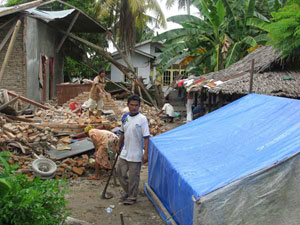

Vol. 73/No. 40 October 19, 2009

|
| Oxfam /Kate Thwaites |
| Padang, Indonesia, after September 30 earthquake that killed more than 1,100. Toll was magnified by social inequalities due to colonial legacy and capitalist underdevelopment. |
According to a UN report, more than 1,100 died and thousands of others were trapped under collapsed buildings. The shoddily built structures and slowness in aid arriving has led to increased deaths and injuries of workers and farmers in the area.
In a separate disaster the day before, an underwater earthquake measuring 8.0 magnitude created a tsunami that sent giant waves of water crashing into the Pacific islands of Samoa, American Samoa, and Tonga.
In Indonesia one of the hardest hit areas is the port city of Padang. It’s the capital of Indonesia’s West Sumatra province where 900,000 people live. Hundreds of buildings were leveled there, including schools, shops, and the city’s three main hospitals.
At Djamil, the largest public hospital in the city, beds were pulled from the wreckage. Doctors had to treat patients outside in makeshift tents.
“Power cuts and a shortage of medicine forced surgeons to halt operations in a hospital overflowing with gravely injured people,” reported the Washington Post. A number of rural villages outside this city were obliterated.
Rescue workers said they needed tractors, bulldozers, and drilling equipment to get through huge slabs of fallen concrete trapping thousands. Many volunteers clawed through the rubble with their bare hands trying to find survivors.
Sutan Maskuri, who lost five siblings, told the New York Times some 44 hours after the tsunami hit, “No one’s been here, no soldiers, no police.” No military or relief vehicles could be seen on the road from Padang, the Times reported.
Indonesia, the world’s fourth most populous nation, remains a semicolonial country dominated by the billionaire rulers of the United States, Australia, Japan, and other imperialist powers.
Sumatra is a center of Indonesia’s oil and gas industry and a growing pulp and paper industry. Both ExxonMobil and Chevron operate oilfields on the island. There have been no reports of damage at those facilities.
“Although Indonesia has emerged as a favorite of investors over the past year,” noted the Wall Street Journal, “it continues to underinvest in infrastructure including hospitals, roads, and power supplies” that could help alleviate “the country’s unusual number of disasters.”
The day after the earthquake, Washington announced it was sending $300,000 in aid. It also promised to set aside another $3 million for further assistance “once an assessment has been made of the disaster,” said State Department spokesman Ian Kelly.
Tsunami hits Samoas and Tonga
The death toll is up to 169 from the tsunami that slammed into the shores of the Samoas and Tonga. This includes 129 in Samoa, a former colony of New Zealand with a population of 220,000. In the U.S. territory of American Samoa where 65,000 live, 31 were killed, and 9 died in Tonga. The Samoas are located in the Pacific Ocean halfway between New Zealand and Hawaii.
The Pacific Tsunami Warning Center in Hawaii issued an alert, but it was just 10 minutes before waves struck the islands. “In some villages absolutely no house was standing,” Samoan prime minister Tuilaepa Sailele told Associated Press.
In Tonga, parts of one island have disappeared with two of the island’s three villages virtually flattened, said government spokesman Lopeti Senituli. Some areas of Pago Pago, the capital of American Samoa, are expected to be without power for a month, reported AP.
The majority of the population in American Samoa lives below the official poverty line. Tuna canneries have been the biggest industries there, with Chicken of the Sea and Starkist plants producing two-thirds of the U.S. supply of canned tuna. They employed more than 4,750 workers.
The tuna industry barons have reaped superprofits as this U.S. territory had been exempt from paying the federal minimum wage. In 2007 Congress raised American Samoa’s canneries’ minimum wage from $3.26 per hour to reach $7.25 by 2014. In response, Chicken of the Sea shut its plant September 30, cutting more than 2,100 workers.
Flooding in South India in early October has killed some 250 people and left 2.5 million people homeless. In the Philippines nearly 300 people were killed and more than 300 displaced after a typhoon struck.
Related articles:
Capitalism’s ‘natural’ disasters
Front page (for this issue) |
Home |
Text-version home